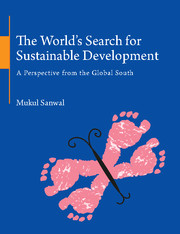Book contents
- Frontmatter
- Dedication
- Contents
- Preface
- Acknowledgments
- Abbreviations
- INTRODUCTION
- 1 Social Dimension of Sustainability
- CONSUMPTION IN AN UNEQUAL WORLD: FRAMING INTERNATIONAL COOPERATION
- CLIMATE POLICY: GLOBAL TO NATIONAL
- SUSTAINABLE DEVELOPMENT: NATIONAL TO GLOBAL
- CONSUMPTION IN A MORE EQUAL WORLD: SHAPING SOCIETAL FUNCTIONS
- GEOPOLITICS TO GEOECONOMICS: RURAL–URBAN DIVIDE, RATHER THAN BETWEEN COUNTRIES
- THE ASIAN CENTURY
- 25 Moving from Ideas to Reality will Depend on How Asia Structures its Urban Future
- Index
25 - Moving from Ideas to Reality will Depend on How Asia Structures its Urban Future
from THE ASIAN CENTURY
Published online by Cambridge University Press: 18 December 2015
- Frontmatter
- Dedication
- Contents
- Preface
- Acknowledgments
- Abbreviations
- INTRODUCTION
- 1 Social Dimension of Sustainability
- CONSUMPTION IN AN UNEQUAL WORLD: FRAMING INTERNATIONAL COOPERATION
- CLIMATE POLICY: GLOBAL TO NATIONAL
- SUSTAINABLE DEVELOPMENT: NATIONAL TO GLOBAL
- CONSUMPTION IN A MORE EQUAL WORLD: SHAPING SOCIETAL FUNCTIONS
- GEOPOLITICS TO GEOECONOMICS: RURAL–URBAN DIVIDE, RATHER THAN BETWEEN COUNTRIES
- THE ASIAN CENTURY
- 25 Moving from Ideas to Reality will Depend on How Asia Structures its Urban Future
- Index
Summary
In 2015, the world stands roughly halfway between the initiation of a global sustainable development policy in the early 1970s and a global vision of middle class well-being within the limits of the planet by 2050. The consumption systems for meeting basic social needs such as food, energy, housing and mobility rely on costly and long-lasting infrastructure, and their production depends on the transformation of natural resources. The transformation of both consumption and production systems, that are at the root of the environmental crisis, has begun with the new model of well-being emerging in China and India. Sustainable development goals are intertwined with the core systems that societies depend on for their welfare and the related transitions in institutions, technologies and lifestyles is moving sustainable development from ideas to reality.
The search for natural resources is a driving force of human well-being. For example, after 1500, as frontiers became global, the rise of the United Kingdom as an industrial nation was enabled by new patterns of resource exploitation – founded largely on the buying and selling of enslaved Africans – that helped move Western Europe economically ahead of natural resource rich, but inward looking, civilizations in China and India [Barbier, 2011]. One-third of the 12 million slaves imported into the United States arrived between 1793 and 1808 and produced 85 per cent of the cotton requirement of the textile mills in Lancshire and when that supply dried up with the Civil War the East India Company expanded its territory into cotton growing areas and within 5 years met the entire requirement from India. As the European market could not sustain the factories cheap milled textiles were introduced into the Indian market; earlier the center of the cotton industry, peasants were made into share croppers producing raw cotton for export to British mills. This industrial revolution was the beginning of the great divergence between the West and the rest. [Beckert, 2014]. After 1950, following World War II, the unprecedented prosperity of the United States was enabled by the multilateral system it established – securing access to commodities at low prices from developing countries emerging from colonialism – as well as the global financial rules that maintained that arrangement; the real price of oil declined in the period 1950–1970 and averaged less than $1.5 a barrel at current prices.
- Type
- Chapter
- Information
- The World's Search for Sustainable DevelopmentA Perspective from the Global South, pp. 305 - 312Publisher: Cambridge University PressPrint publication year: 2015

